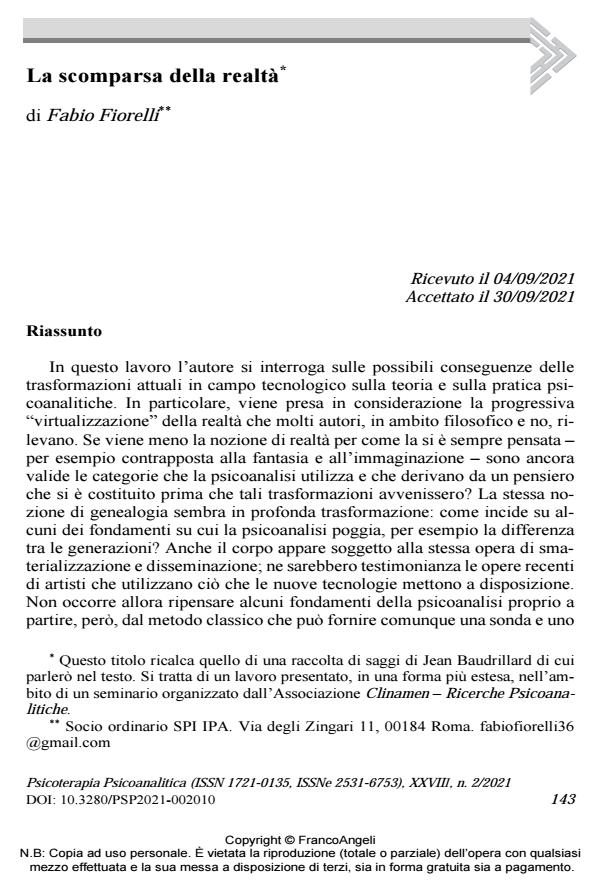The disappearance of reality
Journal title PSICOTERAPIA PSICOANALITICA
Author/s Fabio Fiorelli
Publishing Year 2021 Issue 2021/2
Language Italian Pages 21 P. 143-163 File size 282 KB
DOI 10.3280/PSP2021-002010
DOI is like a bar code for intellectual property: to have more infomation
click here
Below, you can see the article first page
If you want to buy this article in PDF format, you can do it, following the instructions to buy download credits

FrancoAngeli is member of Publishers International Linking Association, Inc (PILA), a not-for-profit association which run the CrossRef service enabling links to and from online scholarly content.
In this work, the author questions the possible consequences of current transformations in the technological field on psychoanalytic theo-ry and practice. In particular, the progressive "virtualization" of reality is taken into consideration, which many authors, in the philosophical and non-philosophical fields, detect. If the notion of reality as it has always been thought of ‒ for example as opposed to fantasy and imagination ‒ is lost, are the categories that psychoanalysis uses and that de-rive from a thought that was constituted before such transformations took place, still valid? The notion of genealogy itself seems to be in profound transformation: how does it affect some of the foundations on which psychoanalysis rests, for example the difference between generations? The body too appears subject to the same work of dema-terialization and dissemination; the recent works of artists who use what new technologies make available would testify to this. Isn’t it necessary then to rethink some of the foundations of psychoanalysis precisely starting, however, from the classical method which can still provide a probe and a scientific look at this new category of human that seems to be forming? Even in the psychoanalytic sphere itself we are reflecting on the impact of these changes, perhaps irreversible, and confronting the need to identify a possible, but probably necessary, point of balance between the psychoanalytic tradition, with its instru-ments of investigation, and the "new" that is manifesting itself.
Keywords: virtual, reality, fantasy, psychoanalysis, technology, trans-formations.
- Agamben G. (2006). Che cos’è un dispositivo? Milano: Nottetempo.
- Ballard J.G. (1973). Crash. Milano: Feltrinelli, 2004.
- Balsamo M. (2019). Ascoltare il presente. Milano-Udine: Mimesis.
- Baudrillard J. (1994). La scomparsa della realtà. Bologna: Fausto Lupetti Editore, 2009.
- Baudrillard J. (1999). Il virtuale ha assorbito il reale. -- http://www.gianfrancobertagni.it/materiali/filosofiacritica/virtualereale.htm
- Bollas C. (2018). L’età dello smarrimento. Milano: Raffaello Cortina.
- Capucci P.L. (a cura di) (1994). Il corpo tecnologico. Bologna: Baskerville.
- Capucci P.L. (2017). Realtà del virtuale. Ravenna: Noema.
- Caronia A. (1994). Il corpo disseminato. In Il corpo virtuale. Dal corpo robotizzato al corpo disseminato nelle reti. Padova: Franco Muzio, 1996.
- Caronia A., Spagnul G. (2012-2013). Nei labirinti della fantascienza. Milano-Udine: Mimesis.
- Cipolletta G. (2012). Passages metrocorporei. Macerata: eum.
- Deleuze G. (1968). Differenza e ripetizione. Milano: Raffaello Cortina, 1997.
- Deleuze G. (1996). L’attuale e il virtuale. aut aut, 276.
- Deleuze G., Guattari F. (1980). Millepiani. Roma: Cooper & Castelvecchi, 2003.
- Egidi Morpurgo V. (2010). Da Prometeo al Big Brother. In Marzi A. (a cura di). Psicoanalisi, identità e internet. Esplorazioni nel cyberspace. (Italian Edition). Edizione Kindle, 2010.
- Ferraris M. (2021). Documanità: Filosofia del nuovo mondo. Bari: Gius. Laterza & Figli Spa, Edizione digitale.
- Fiorelli F. (2021). Trasformazioni dell’identità di genere: lo sguardo dello psicoanalista. In Monterosa L., Iannitelli A., Buonanno A. (a cura di). L’ultracorpo. Roma: Alpes.
- Floridi L. (2014). La quarta rivoluzione. Milano: Raffaello Cortina, 2017.
- Floridi L. (2019). Pensare l’infosfera: la filosofia come design concettuale. Formato Kindler. Milano: Raffaello Cortina, 2020.
- Gibson W. (1984). Neuromante. Milano: Editrice Nord, 1986.
- Harari Y.N. (2018). 21 lezioni per il XXI secolo. Firenze-Milano: Giunti, 2019.
- Kaës R. (2012). Malessere. Roma: Borla, 2013.
- Kurzweil R. (2005). La singolarità è vicina. Santarcangelo di Romagna: Maggioli, 2014.
- Lévy P. (1994). L’intelligenza collettiva. Milano: Feltrinelli, 1996.
- Lyotard J.F. (1979). La condizione postmoderna. Milano: Feltrinelli, 1981.
- Maldonado T. (1994). Reale e virtuale. Milano: Feltrinelli.
- McLuhan M. (1964). Gli strumenti del comunicare. Milano: Il Saggiatore, 1967.
- McLuhan M. (1989). Il villaggio globale. Milano: SugarCo, 1992.
- Mitscherlich A. (1963). Verso una società senza padre. Milano: Feltrinelli, 1970.
- Parikka J. (2012). What is Media Archaeology?. Cambridge: Polity Press.
- Perniola M. (2010). La società dei simulacri. Nuova edizione. Ágalma: Rivista di Studi Culturali e di Estetica, 20.
- Rovatti P.A. (2020). Distanza e prossimità. Una questione da ripensare. In Frontiere della Psicoanalisi, 1(1), 75-83. DOI: 10.48270/9885
- Serres M. (2012). Non è un mondo per vecchi. Torino: Bollati Boringhieri, 2013.
- Žižek S. (2004). What can Psychoanalysis Tell us About Cyberspace?. Psychoanalytic Review, 91(6).
Fabio Fiorelli, La scomparsa della realtà in "PSICOTERAPIA PSICOANALITICA" 2/2021, pp 143-163, DOI: 10.3280/PSP2021-002010